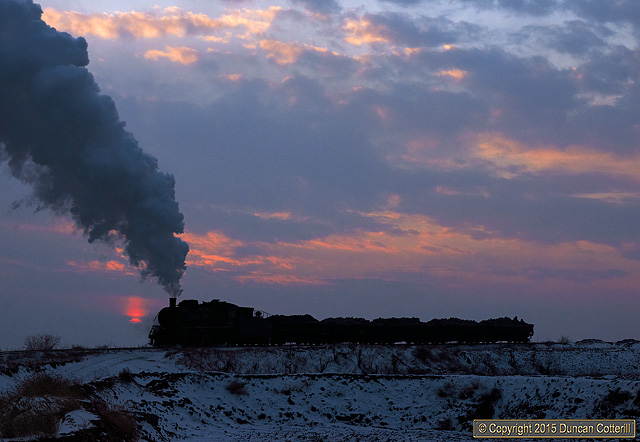STEAMING ON
Industrial Steam Survivors In Liaoning, Inner Mongolia and Xinjiang
China - 18 November to 8 December 2015 - Report by Duncan Cotterill
INTRODUCTION
There aren't many steam lines left in China these days but those that remain can still produce some very rewarding pictures. This report covers a three-week trip to China centred on the best of the remaining industrial steam operations, Fuxin and Sandaoling. We also visited Pingzhuang, a risky choice as it should be diesel but goes back to using steam occasionally, and Fushun, worth a look as we were in the area but not a place that was ever going to produce mastershots.Modern traction photography was never the object of the trip but observations during the trip are included and there are a few photos as well.
Going Down?
Chinese steam may be in serious decline but it isn't quite finished yet.The best of the few surviving lines are still very good and well worth a visit, even at the end of 2015.
JS.8190 drifted down the bank towards the Xuanmeichang washery at Sandaoling with a loaded coal train shortly after sunset on 1 December 2015.
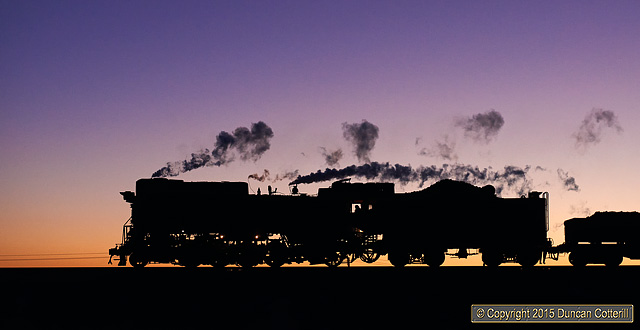
TRAVEL ARRANGEMENTS
As usual I travelled with Peter Breeze and Sun Xiaolan. Flights from the UK to Beijing and back were with Finnair via Helsinki. In China we used a mixture of rail, air and road transport to get between centres and had a vehicle and driver to get us around locally at each centre. Xiaolan made all the arrangements within China except for booking the Beijing hotels, which were much cheaper when booked from the UK via booking.com.BEIJING TO FUSHUN
18 November 2015Finnair was just a few minutes late into Beijing and we got through the formalities relatively quickly and met up with Xiaolan. We took the airport bus to Beijing (Main) station, taking 75 min and leaving plenty of time to enjoy some dumplings before boarding train D6, the 13:21 to Shenyang Bei, formed of CRH5A high speed EMUs CRH5.5032 and CRH5.5027.
SIGHTINGS EN ROUTE
DF4C.5215 was seen arriving at Beijing on K7718 from Chengde just before we left. DF4B.2557 and DF7.0015 were seen on shed, along with a few DF11s and DF11G twins. The majority of locos seen around the main station and shed were electrics, mainly SS9Gs, HXD3Cs and HXD3Ds but a couple of SS8s and SS9s were also seen.SS4Bs worked about 50% of freights noted between Beijing and Qinhuangdao/Shanhaiguan with HXD2B on most of the others. Last year virtually everything was worked by HXD2Bs. A few DF8Bs were seen en-route while most shunting was in the hands of DF7Bs or DF7Cs. A DaQin line coal train was seen near Qinhuangdao with HXD1.0161 on the front and HXD1.0022 mid-train. Another coal train in the same area was worked by HXD2.0017.
In previous years it was common to see long distance passengers on this electrified route worked by DF4D or DF11 diesels but the introduction of HXD3C and HXD3D electrics seems to have almost eliminated the practice. The only diesel worked passenger seen was at Qinhuangdao where DF11Z.0002 waited with the stock for an overnight Beijing – Nanjing service.
Nothing of interest was seen in the dark east of Shanhaiguan.
At Shenyang Bei we were met by Fuxin based steam enthusiast and photographer Gu Manchun who would be our driver for most of the next 10 days. We continued by road to the New Nanhai Oasis Hotel on Dandong Road in western Fushun, not far from the old steelworks.
FUSHUN INDUSTRIAL RAILWAYS
19 to 20 November 2015The main object of our visit to Fushun was to photograph the remaining steam workings at the Old Steelworks, also known as the Special Steelworks. Access to the stabling point can be tricky and our attempts to arrange an official visit via Mr Gu came to nothing. For the first day we decided to maintain a low profile and stayed around the Xifengnan Lu level crossing on the line that runs along the southern perimeter of the site, connecting various parts of the works. Activity levels weren't high and a diesel, GKD1A.0219, handled the bulk of the work. It appeared that steam, in the form of SY.1633, was only used when a second engine was required. A total of seven shunts were seen over a period of six hours, two by the SY and five by the diesel. The weather was cold and grey throughout, with a little old snow on the ground.
We returned to the old steelworks the following morning in similarly dull conditions. Activity levels were even lower than the previous day so we decided to leave for Fuxin early, in the hope that the weather might be better there. Before leaving we paid a very quick visit to the stabling point, leaving before we could be spotted and thrown out. To our surprise there were three SYs in steam and a fourth cold but undoubtedly still in service. The condition of a fifth SY couldn't be determined as it was inside one of the sheds but nothing we saw indicated that it was out of use. Apart from GKD1A.0219, no diesels were seen in use. DFH5.0408 was still in the same place it has been on each of my two previous visits. It looked out of use but is, apparently, still in service.
FUSHUN OLD STEELWORKS LOCOS
SY.1632, 1633, 1634 in steamSY.1630 cold, serviceable
SY.1050 cold, possibly serviceable
GKD1A.0219 in service
DFH5.0408 apparently still in service.
During the steelworks lunchbreak on 19 November we paid a very brief visit to the opencast mine washery at Guchengzi. Two old Japanese ED85 electrics were seen, 1211 in fresh green paint and another, too far away to identify, in blue livery and with a three digit number. The only other loco seen was one of the Chinese built ZG150-1500s, in green but also too far away to identify.
The electric line that runs along the southern perimeter of the old steelworks appeared to have been used recently, judging by the shiny rails, but we didn’t see any trains. On the other side of the steelworks the old passenger line to Jixiu showed no signs of recent use but was in remarkably good condition for a line that hasn’t seen regular trains for at least four years.
Scrap Metal
Fushun Special Steelworks still uses SY Class 2-8-2s on some shunting duties.SY.1633 eased a train of scrap steel over the Xifengnan Lu level crossing on 19 November 2015. Although access to the steelworks itself is not permitted, the line linking various parts of the site runs along the southern periphery and is accessible at a few points, such as this.
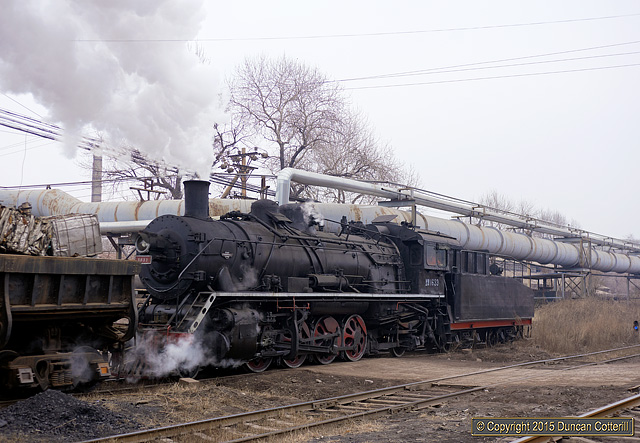
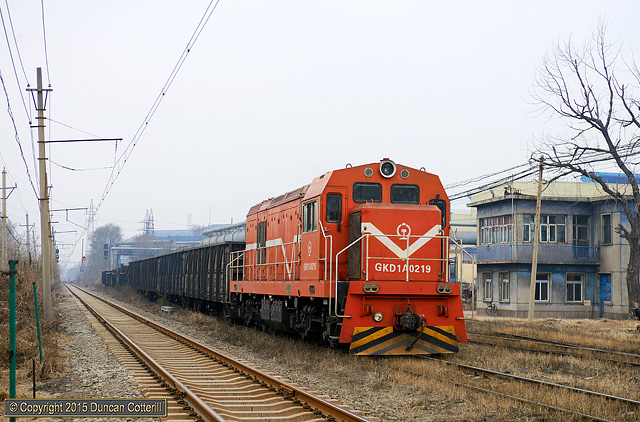
Orange Box
During our visit to Fushun Special Steelworks a diesel performed most of the shunting with the SY only being used when the diesel was already occupied.GKD1A.0219 approached the Xifengnan Lu level crossing with an assortment of wagons on 19 November 2015.
The electrified line in the foreground is the lightly used mining railway branch to the New Steelworks.
FUSHUN TO FUXIN
20 November 2015We travelled from Fushun to Fuxin by road, taking around 3 hours to cover the 220km. The only trains seen were a couple of HXD3B hauled freights on the Shenyang northern freight bypass. Construction work for a new Beijing – Chengde – Chaoyang – Fuxin – Shenyang high-speed line was evident in places.
We stayed at the Xingguang Hotel on Hongshu Road in Fuxin, not far from the power station.
FUXIN MINING RAILWAY
20 to 22 and 25 to 28 November 2015Operations at Fuxin were very similar to last year with steam working concentrated on Wulong Yard, Wulong Mine and the nearby spoil tip. Only two DF5D diesels were seen during our visit, DF5D.0065 and 0080, and they worked all trains to Wangying mine and a few coal trains serving Wulong mine. There were more working steam locos than on our previous visit last year. A total of eight SYs were seen in action with between five and six in use on any particular day. The SYs continue to face west at Wulong Yard as they have for years. The exception was SY.1460, fresh from works, which faced the other way for a couple of days before being turned.
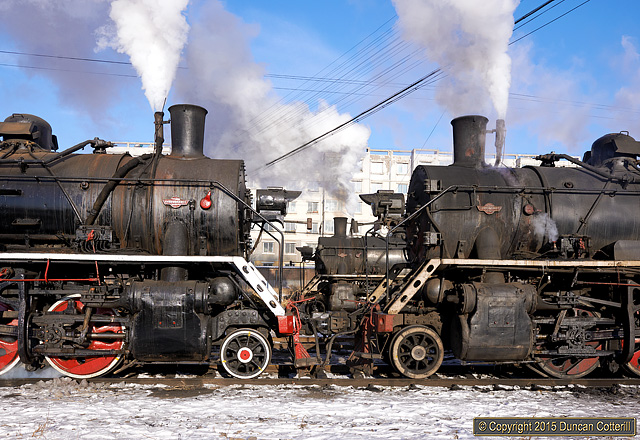
The Gathering
Every morning, between 08:00 and 09:00, Fuxin's locos come together near the railway offices at Ping'an to change crews. On 26 November 2015 ex-works SY.1460 (left) locked couplers with SY.1195 (right). SY.1210 was visible behind. SY.1460 would soon be turned so it faced the same way as all the other locos.SY.1460 and SY.1195 are Fuxin's newest and oldest operational steam locos, dating from June 1986 and October 1982 respectively.
Wangying Spoil
Fuxin's diesels worked all traffic to or from Wangying Mine during our visitDF5D.0080 propelled ten spoil tippers east from Wangying through Ping'an towards Wulong Yard on the morning of 26 November 2015. From Wulong Yard the spoil would be taken to Wulong tip in two five-wagon trains worked by SYs.
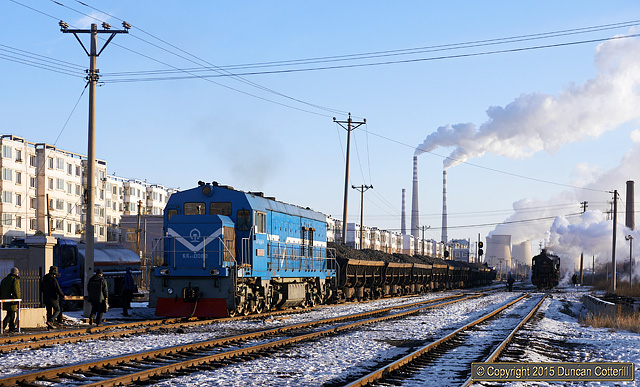
Spoil was being tipped in the old opencast pit as well as on the tip above Wulong Mine and trains from either mine could go to either tipping location. While trains going up Wulong Tip were formed of four or five side tippers, those going to the opencast had seven side tippers, making them easily identifiable. Large rocks and ash always went to Wulong Tip but smaller spoil could go to either location. The opencast seemed busiest during the mornings with more activity on Wulong Tip in the afternoons.
Spoil trains going up Wulong Tip were always propelled and always steam worked. The lower line on the tip appeared to be out of use and this was confirmed by a railway employee. There are now three lines on the upper level of the tip but the newest line didn't appear to be in use yet and was still being worked on by track gangs during our visit. The pointsman's cabin has been moved downhill a couple of hundred metres to the junction of the new line. The two operational lines on the upper level were each used fairly equally and it was common for trains to run in pairs at busier times, i.e. two trains would go up one after the other, about 15 minutes apart, both would unload then go down, one after the other, again about 15 minutes apart.
Spoil trains going to the opencast were always steam worked and always propelled into the pit. If coming from Wulong Mine, the loco would pull the train out of the mine then run round in the loop at Ping'an Mine before propelling the train into the opencast. Trains from Wangying to the opencast could run with the loco at either end from Wulong Yard to Ping'an Mine but would always propel into the pit. There were two locations on the south side of the pit where tipping could take place and we saw trains using both locations. On one occasion two trains were in the pit tipping simultaneously.
In previous years it was common to see one or two trains of ash being tipped above Wulong almost every day but on this trip we saw very few. Some days there was one train but on many there was no ash tipped in daylight. None of the ash trains we saw produced the spectacular clouds of dust that were common a few years ago. We didn’t bother with the line east of Wulong yard on this trip as traffic levels seemed to be very low and unpredictable without the daily ash trains.
All the spoil and ash trains seen were worked by SYs but trains of ChIna Railway wagons to/from Wulong Mine could be steam or diesel, with the diesels working the heavier trains. We got the impression that Wulong wasn't producing as much coal as last year but the spoil output seemed to be quite high.
A new flow of traffic was coal loaded into BaXin Railway wagons from road vehicles at the recently refurbished siding partway up Wulong Tip, just below the tipperman's bothy. The wagons would usually be brought up from Wulong Yard by an SY in the morning, filled during the day and taken back in the afternoon. The parked wagons, road vehicles and clouds of coal dust limited the scope for photography at this previously popular photo location. The BaXin Railway is a new 490km line going north from Xinqiu, the former eastern terminus of the mining railway, via Daban, to Bayanwula, near the Mongolian border.
The first few days at Fuxin were generally overcast, although there were a few sunny breaks, but after we'd returned from Pingzhuang on 25 November the weather turned much colder and brighter. There was a little snow on the ground but it gradually disappeared as time went on.
The usual hordes of local photographers (just general photographers, not railway enthusiasts) descended on Ping'an yard for shift change on weekend mornings, accompanied by the railway security people trying to chase them off. It all made photography difficult as they continually got in each other’s and everybody else's way. Far better to photograph the gathering of engines during the week when it's only you and the loco crews there. A good alternative on weekend mornings is the approach to Wulong Mine where there's usually at least one loco shunting, even during shift change.
We also saw a few Chinese railway enthusiasts around Fuxin, including a couple of Pang Dawei’s friends, and met John Parker, John Athersuch and a trio of Japanese enthusiasts by the lineside on various occasions. Otherwise we generally had the place to ourselves.
DF5D.0065, 0080.
Spoil trains going up Wulong Tip were always propelled and always steam worked. The lower line on the tip appeared to be out of use and this was confirmed by a railway employee. There are now three lines on the upper level of the tip but the newest line didn't appear to be in use yet and was still being worked on by track gangs during our visit. The pointsman's cabin has been moved downhill a couple of hundred metres to the junction of the new line. The two operational lines on the upper level were each used fairly equally and it was common for trains to run in pairs at busier times, i.e. two trains would go up one after the other, about 15 minutes apart, both would unload then go down, one after the other, again about 15 minutes apart.
Spoil trains going to the opencast were always steam worked and always propelled into the pit. If coming from Wulong Mine, the loco would pull the train out of the mine then run round in the loop at Ping'an Mine before propelling the train into the opencast. Trains from Wangying to the opencast could run with the loco at either end from Wulong Yard to Ping'an Mine but would always propel into the pit. There were two locations on the south side of the pit where tipping could take place and we saw trains using both locations. On one occasion two trains were in the pit tipping simultaneously.
In previous years it was common to see one or two trains of ash being tipped above Wulong almost every day but on this trip we saw very few. Some days there was one train but on many there was no ash tipped in daylight. None of the ash trains we saw produced the spectacular clouds of dust that were common a few years ago. We didn’t bother with the line east of Wulong yard on this trip as traffic levels seemed to be very low and unpredictable without the daily ash trains.
All the spoil and ash trains seen were worked by SYs but trains of ChIna Railway wagons to/from Wulong Mine could be steam or diesel, with the diesels working the heavier trains. We got the impression that Wulong wasn't producing as much coal as last year but the spoil output seemed to be quite high.
A new flow of traffic was coal loaded into BaXin Railway wagons from road vehicles at the recently refurbished siding partway up Wulong Tip, just below the tipperman's bothy. The wagons would usually be brought up from Wulong Yard by an SY in the morning, filled during the day and taken back in the afternoon. The parked wagons, road vehicles and clouds of coal dust limited the scope for photography at this previously popular photo location. The BaXin Railway is a new 490km line going north from Xinqiu, the former eastern terminus of the mining railway, via Daban, to Bayanwula, near the Mongolian border.
The first few days at Fuxin were generally overcast, although there were a few sunny breaks, but after we'd returned from Pingzhuang on 25 November the weather turned much colder and brighter. There was a little snow on the ground but it gradually disappeared as time went on.
The usual hordes of local photographers (just general photographers, not railway enthusiasts) descended on Ping'an yard for shift change on weekend mornings, accompanied by the railway security people trying to chase them off. It all made photography difficult as they continually got in each other’s and everybody else's way. Far better to photograph the gathering of engines during the week when it's only you and the loco crews there. A good alternative on weekend mornings is the approach to Wulong Mine where there's usually at least one loco shunting, even during shift change.
We also saw a few Chinese railway enthusiasts around Fuxin, including a couple of Pang Dawei’s friends, and met John Parker, John Athersuch and a trio of Japanese enthusiasts by the lineside on various occasions. Otherwise we generally had the place to ourselves.
FUXIN MINING RAILWAY LOCOMOTIVES
SY.1195, 1210, 1320, 1359, 1395 (Zhu De Hao), 1397, 1460 (ex works), 1818 (1414) all in useDF5D.0065, 0080.
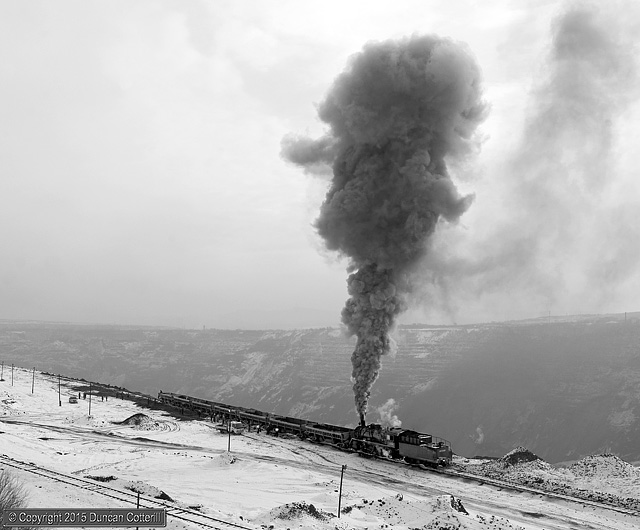
Tip In The Pit
SY.1210 set off from the opencast pit with empty spoil tippers on the morning of 21 November 2015.More spoil was being tipped in the pit this year and most tipping appeared to be done in the mornings. Two trains can tip here simultaneously, one in the area SY.1210 is shown leaving and the other at the far end of the line that can be seen in the foreground.
Sunset Silhouette
There wasn't any water in the settling pond on Wulong Tip this year but the sunset silhouettes were still worth trying.SY.1359 produced a volcanic exhaust as it pushed a loaded spoil train up the tip at precisely the right moment on 27 November 2015.
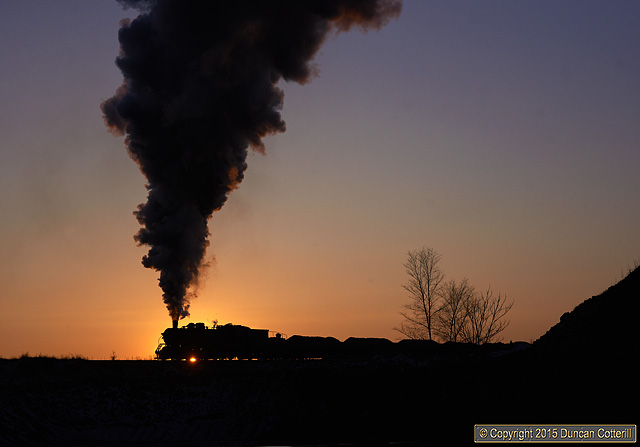
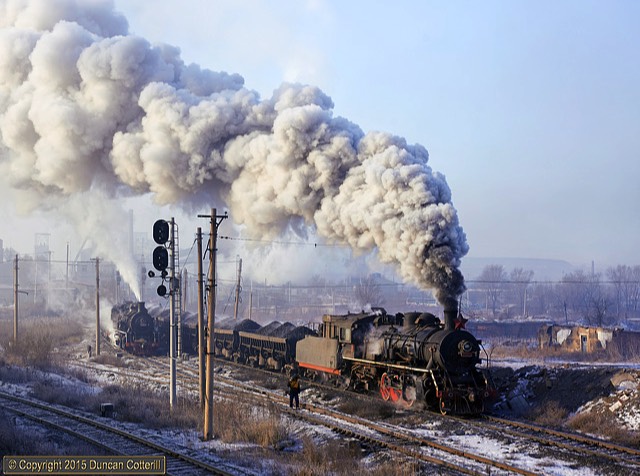
Wulong Morning
SY.1320 set off from Wulong Mine with spoil loads for the opencast pit on the morning of 28 November 2015. On the left, SY.1460 waited to back the next set of empties under the loader.SY.1320's cabside badge (below)

FUXIN TO PINGZHUANG AND BACK
23 and 25 November 2015Although it's a long trek from Fuxin, we decided to risk a visit to Pingzhuang to see what was happening. The journey took around five hours on icy roads with the return taking an hour less in much better conditions. North of Chaoyang the road parallels the new coal line from Chifeng to Jinzhou but we only saw one train, a southbound loaded coal train hauled by a DF8B, near Chaoyang on 23 November. The loco appeared to have the markings of an independent operator but it wasn't possible to ascertain any further information. More evidence of the new Beijing – Chengde – Chaoyang – Fuxin – Shenyang high speed line was seen east of Chaoyang.
We stayed at the Baoshan Hotel in the centre of Pingzhuang.
PINGZHUANG MINING RAILWAY
23 to 25 November 2015Since Pingzhuang acquired two ex China Railway DF4s a couple of years ago, it's been difficult to predict how much steam activity to expect. Some visitors have found the diesels doing all the work, while others have found the diesels out of action and steam working everything.
On arrival at Zhuangmeizhan, location of the opencast mine washery and loco servicing point, we found a freshly overhauled SY.1487 being prepared for a trip to Pingzhuang Nan to collect some empties. The crew told us that the diesels weren't being used because of the cost of fuel and that four SYs were in service, three in use and one standby. It was now early afternoon and the morning's cloud had started to clear. After photographing SY.1487 leaving Nan, we went to Gushan Yijing in the hope that it would work through to Lijing but it didn't. We did see SY.1441 on a train of side tippers going west from Lijing, presumably to Erjing. The rest of the afternoon was quiet with no activity we were aware of.
Return To Steam
We didn't expect a great deal from our visit to Pingzhuang but within 40 minutes of our arrival we were photographing SY.1487 leaving Pingzhuang Nan with a long train of empties for Zhuangmeizhan.(below) The overhaul date of 28 July 2015 on SY.1487's tender.
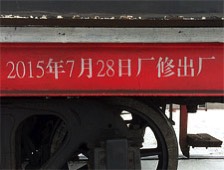
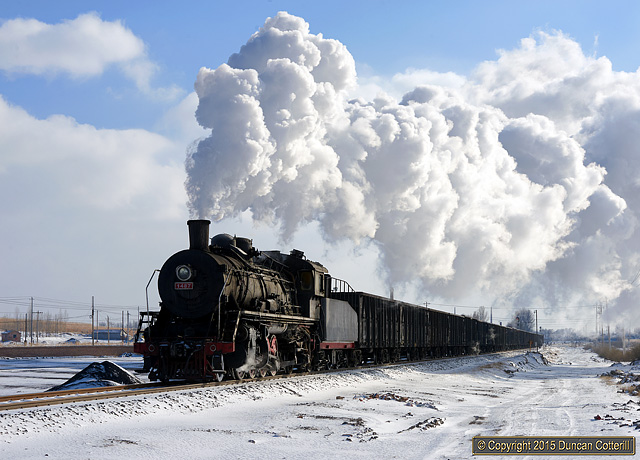
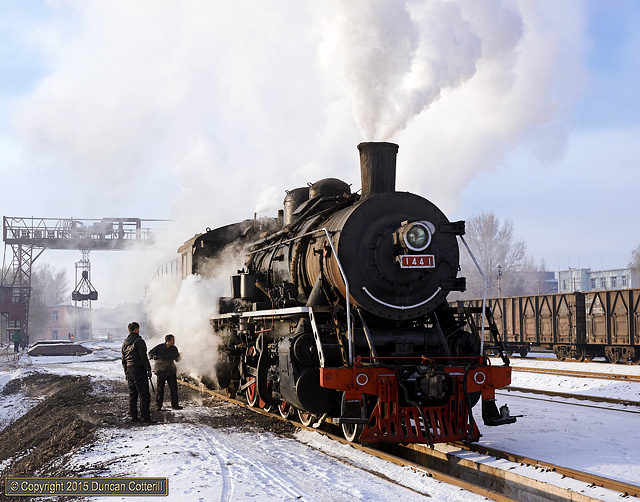
Ashing Out
SY.1441 visited the ashpit at Zhuangmeizhan on the morning of 24 November 2015.Pingzhuang's steam locomotives return to Zhuangmeizhan at shift change time for servicing and to change crews. The locos are usually back for 08:00 and remain for around an hour before going back to work.
On the second morning we found SY.1441 and SY.1487 being serviced at the Zhuangmeizhan stabling point before going to work. SY.1487 then took a short train of empties towards Lijing while SY.1441 went off in the opposite direction with empties for a new mine to the south-west, between the old opencast mine and the spoil tip. This line climbs away from Zhuangmeizhan using the connection that previously linked the opencast and deep mine systems then continues to climb, following the route of the line leading to the disused spoil tips. The loading point at the mine has a runround loop and appears to be level or even slightly uphill for departing trains. These would be chimney first if steam worked. We didn’t see any departures and can’t confirm whether the locos have to work hard. All of the lines on the spoil tip itself appear to be out of use and most have been lifted.
By the time SY.1441 collected empties from Nan around midday the sky had clouded over. The loco took an eternity to shunt almost all of the empties into the washery sidings. Despite the rundown of the opencast mine and the closure of its railway system, the washery was still producing large volumes of coal, more than the Gushan mines or the new mine. SY.1441 later took the few remaining empties towards Lijing while SY.1487 went to the new mine, collected the loads from there, combined them with the loads waiting at the washery and took them all to Nan. It returned with a very long train of empties in the late afternoon, splitting it at Wufeng and taking half up to Zhuangmeizhan. The light had gone by then so we didn't wait to see if it returned for the other half of the train.
The weather was still dull on our final morning so we decided to check out the line to the new mine on the way to the stabling point. As we approached the main road crossing north of Wufeng, the gates closed ahead of us and DF4B.1251 rumbled past with a long train of loads for Nan. This loco was in orange passenger livery and carried Pingzhuang Mining Administration markings. At the stabling point SY.1441 was being serviced and then went to sit in the yard with its wheels scotched. It didn't look likely to do anything for a long time. We'd already decided to go back to Fuxin during the day and left shortly afterwards.
DF4B.1251 in service
By the time SY.1441 collected empties from Nan around midday the sky had clouded over. The loco took an eternity to shunt almost all of the empties into the washery sidings. Despite the rundown of the opencast mine and the closure of its railway system, the washery was still producing large volumes of coal, more than the Gushan mines or the new mine. SY.1441 later took the few remaining empties towards Lijing while SY.1487 went to the new mine, collected the loads from there, combined them with the loads waiting at the washery and took them all to Nan. It returned with a very long train of empties in the late afternoon, splitting it at Wufeng and taking half up to Zhuangmeizhan. The light had gone by then so we didn't wait to see if it returned for the other half of the train.
The weather was still dull on our final morning so we decided to check out the line to the new mine on the way to the stabling point. As we approached the main road crossing north of Wufeng, the gates closed ahead of us and DF4B.1251 rumbled past with a long train of loads for Nan. This loco was in orange passenger livery and carried Pingzhuang Mining Administration markings. At the stabling point SY.1441 was being serviced and then went to sit in the yard with its wheels scotched. It didn't look likely to do anything for a long time. We'd already decided to go back to Fuxin during the day and left shortly afterwards.
PINGZHUANG MINING RAILWAY LOCOMOTIVES
SY.1441, 1487 in serviceDF4B.1251 in service
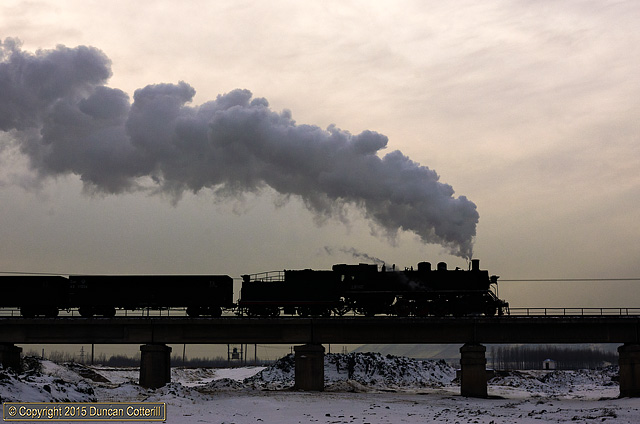
Watery Sunset
The good light at Pingzhuang didn't last very long and it was cloudy for most of day on 24 November 2015. It looked like there might be a decent sunset but the sun had dropped into the murk before SY.1487 left Pingzhuang Nan with empties for Zhuangmeizhan.FUXIN TO SANDAOLING
28 to 29 November 2015We travelled by road from Fuxin to Jinzhou Nan then took train D6 at 13:42 to Beijing, again formed of a pair of CRH5 high speed EMUs. Observations were very similar to those on the outward journey but with DF11Z.0004 on the empty stock at Qinhuangdao. An original DF7 was seen shunting a yard in the eastern outskirts of Beijing and another was in the depot at Beijing, probably the same one seen on the way out. DF11G.0013/0014 were noted at Beijing on train Y510, the 13:10 from Qinhuangdao.
At Beijing we were met by Xiaolan’s friend Wang Rong and driven to the Capital Airport Hotel where we would spend the night. Up early the following morning for the shuttle bus to Terminal 3 and our flight to Hami. CA1267 was on time and worked by an Air China Boeing 737-700.
At Hami Airport we were met by GuLi and our driver and travelled by road to Sandaoling, arriving at 13:30.
SANDAOLING MINING RAILWAY
29 November to 6 December 2015Very little change since last year with distinctly separate opencast and deep mine operations continuing. We didn't spend a lot of time on the deep mine side but did see four JS at Nanzhan on more than one occasion. The Beiquan mines didn't seem very busy and three visits and over six hours waiting only produced one train, a departure from Yijing worked by JS.8314 on 30 November. That was the only deep mines loco positively identified. The others always scurried away before their numbers could be recorded. We were aware of two more trains to Erjing but were doing other things when they ran and didn't see anything more than a distant exhaust. The line between Yijing and Erjing looked like it was out of use last year but has been relaid, or at least reballasted, and Yijing itself appears to be producing coal again after a period when most of the coal loaded there seemed to come in from elsewhere by road.
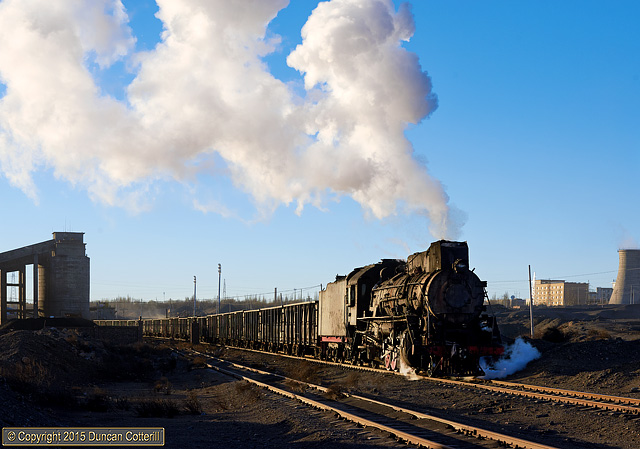
Yijing Departure
The Beiquan mines, Yijing and Erjing, were quieter than on recent trips and only one of our visits actually produced a train. JS.8314 finally departed Yijing just before sunset on 30 November 2015 after its fourth very slow pass through the loader with the entire train, a process that took around three hours to complete.While we were waiting the weather changed completely with the gentle southerly wind giving way to a strong northerly, the temperature dropping by several degrees and the haze and cloud vanishing, all in around an hour.
Several trains were seen on the new line to Shadunzi, all around 40-50 wagons long and worked by a DF8B diesel. The three trains seen on the line to Liushuquan were also diesel hauled.
The opencast coal operation based at Dongbolizhan was as good as ever with five different JSs seen in use and four trains in operation much of the time. The locos appeared cleaner than they have been for several years with a couple of them capable of producing a passable glint in the right light. Traffic levels and operating patterns seemed to vary considerably from day to day with trains every 20-30 minutes at some times and gaps of well over an hour at others. The lunchtime breaks weren't as long as they had been on some trips. One thing that was consistent was that the locos were always worked hard on the climb out of the pit and the sound of the exhaust ricochetting off the walls could be deafening. It might not be main line steam but nobody's told the loco crews.
Coal was being loaded at three separate locations in the pit, all at or near Xikeng. Trains using the blue loader generally took about 30 minutes to load and all appeared to go to the washery. The practice of holding an empty train on one of the two lines leading to the blue loader while the loaded train departed on the other line appeared to have ceased. Both lines were seen in use but at different times and only one would be used by trains to or from the loader on any particular day. Empties were usually held on the main line east of Ba'erzhan, whether they were destined for the blue loader or one of the other loading points.
Trains were also being loaded on the old line to Xibolizhan, about halfway between the blue loader and Ba'erzhan, using a huge electric shovel. While it took around 45 minutes to load a train, it sometimes took almost as long for the loco to get the train moving. So much coal seemed to miss the wagons and fall on the track that the locos often slipped violently for several minutes before getting a grip. Once it took over 40 minutes before the loco found its feet and on another occasion the crew had to summon assistance from a second loco, resulting in the unusual sight of double headed JSs in the pit. After several days of slips and delays, the practice seemed to change and subsequent trains were loaded from the front rather than the back, meaning the loco was on clean rails at the point when it had to work the hardest. No problems were noted after that.
As noted in a previous report, some of the trains loaded by the electric shovel went through Dongbolizhan and down the ramp past the works before swinging through 180 degrees into a headshunt around the back of the coking plant and parallel to the Shadunzi line but at a lower level. They then reversed into an unloading area between the coking plant and Nanzhan to unload. We were told that this location is known as Jianmeixian. Other trains loaded by the shovel appeared to go to the washery.
Occasionally trains would be loaded by a smaller front loader on the southernmost of the two tracks leading to the blue loader but this usually took well over an hour to complete and we only saw a handful of trains loaded there, one of which left almost empty.
The opencast coal operation based at Dongbolizhan was as good as ever with five different JSs seen in use and four trains in operation much of the time. The locos appeared cleaner than they have been for several years with a couple of them capable of producing a passable glint in the right light. Traffic levels and operating patterns seemed to vary considerably from day to day with trains every 20-30 minutes at some times and gaps of well over an hour at others. The lunchtime breaks weren't as long as they had been on some trips. One thing that was consistent was that the locos were always worked hard on the climb out of the pit and the sound of the exhaust ricochetting off the walls could be deafening. It might not be main line steam but nobody's told the loco crews.
Coal was being loaded at three separate locations in the pit, all at or near Xikeng. Trains using the blue loader generally took about 30 minutes to load and all appeared to go to the washery. The practice of holding an empty train on one of the two lines leading to the blue loader while the loaded train departed on the other line appeared to have ceased. Both lines were seen in use but at different times and only one would be used by trains to or from the loader on any particular day. Empties were usually held on the main line east of Ba'erzhan, whether they were destined for the blue loader or one of the other loading points.
Trains were also being loaded on the old line to Xibolizhan, about halfway between the blue loader and Ba'erzhan, using a huge electric shovel. While it took around 45 minutes to load a train, it sometimes took almost as long for the loco to get the train moving. So much coal seemed to miss the wagons and fall on the track that the locos often slipped violently for several minutes before getting a grip. Once it took over 40 minutes before the loco found its feet and on another occasion the crew had to summon assistance from a second loco, resulting in the unusual sight of double headed JSs in the pit. After several days of slips and delays, the practice seemed to change and subsequent trains were loaded from the front rather than the back, meaning the loco was on clean rails at the point when it had to work the hardest. No problems were noted after that.
As noted in a previous report, some of the trains loaded by the electric shovel went through Dongbolizhan and down the ramp past the works before swinging through 180 degrees into a headshunt around the back of the coking plant and parallel to the Shadunzi line but at a lower level. They then reversed into an unloading area between the coking plant and Nanzhan to unload. We were told that this location is known as Jianmeixian. Other trains loaded by the shovel appeared to go to the washery.
Occasionally trains would be loaded by a smaller front loader on the southernmost of the two tracks leading to the blue loader but this usually took well over an hour to complete and we only saw a handful of trains loaded there, one of which left almost empty.
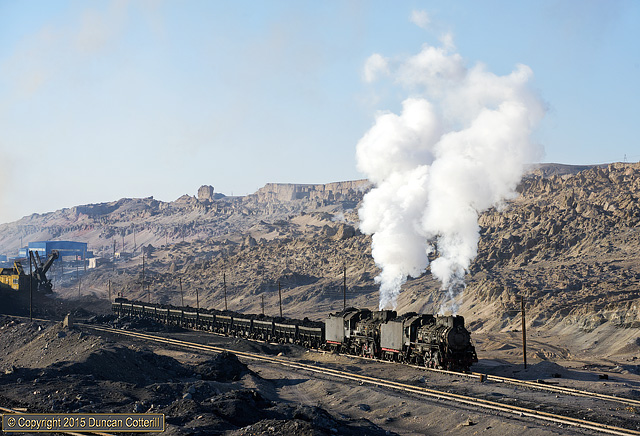
Double Header
Rail conditions were very difficult on the line serving the electric shovel and several trains had difficulty getting away, possibly due to the coal that missed the wagons and ended up on the track. After many minutes of violent slipping JS.8190's crew summoned assistance from JS.8197 and the pair managed to get the train moving. A few seconds after the picture was taken, both locos shut off, JS.8197 detached and JS.8190 continued as normal.An hour later it was JS.8197's turn to start a train from the same spot, a task it only managed after around 30 minutes of slipping.
Leaving Xikeng
JS.8225 left the blue loader at Xikeng with a loaded coal train for the Xuanmeichang washery on the afternoon of 4 December 2015, passing JS.8081 loading at the electric shovel.For much of the time we were at Sandaoling there were two loading points in action at the same time and four trains serving them, producing a loaded departure every 20-30 minutes. At other times there could be gaps of over an hour between trains.
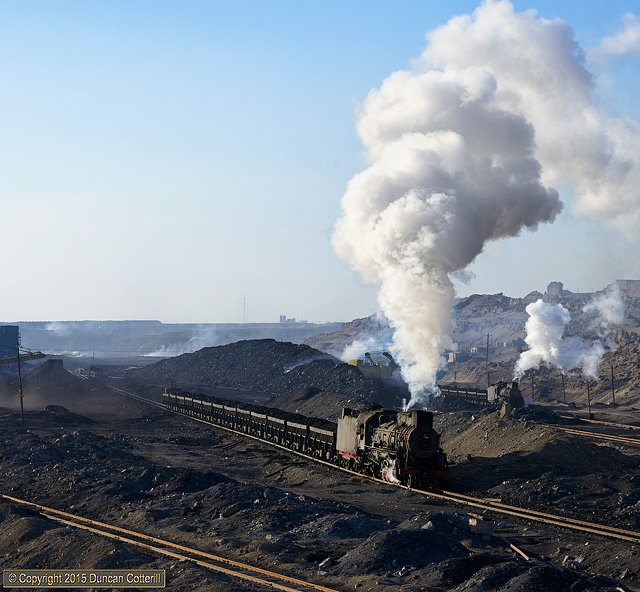
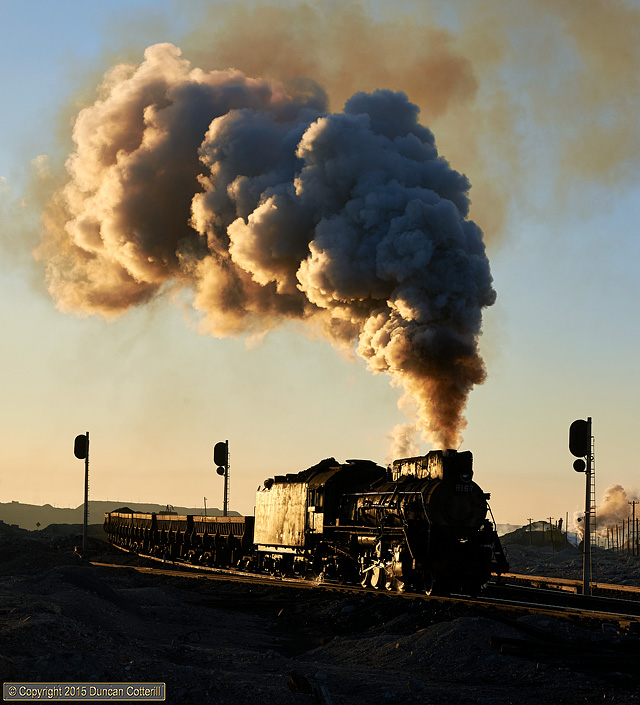
Glint Light
For the first time in several years, some of Sandaoling's locos were clean enough to glint. JS.8167, the shiniest of them all, approached Ba'erzhan with a lightly loaded train shortly before sunset on 2 December 2015.Trains loading on this line generally took an eternity to fill, so it was a surprise when JS.8167 set off around half an hour after arriving with most of the train still empty.
The passenger train was reported to have stopped running during the summer but this wasn't quite the whole story. It didn't run as a train but one of the opencast coal locos still made the trip to Ba'erzhan or Xikeng every morning, light engine, leaving Dongbolizhan at 08:40 and getting back just after 09:00. The few remaining passengers were carried on the footplate of the loco.
Shift change still takes place at Dongbolizhan between 08:00 and 09:00 each morning with all the opencast coal locos in attendance. On most mornings all four active locos were there by 08:15 but occasionally one would arrive later or change crews on the line from the washery near Kengkouzhan. The first empty train would normally leave between 09:10 and 09:20, shortly after the light engine had returned from Ba’erzhan. The timing of the first loaded train out of the pit also varied but it was usually between 10:10 and 10:40. There were only two loaded trains out of the pit before 12:30 on some days but as many as five on the busiest. Track work sometimes resulted in long gaps in the service.
Shift change still takes place at Dongbolizhan between 08:00 and 09:00 each morning with all the opencast coal locos in attendance. On most mornings all four active locos were there by 08:15 but occasionally one would arrive later or change crews on the line from the washery near Kengkouzhan. The first empty train would normally leave between 09:10 and 09:20, shortly after the light engine had returned from Ba’erzhan. The timing of the first loaded train out of the pit also varied but it was usually between 10:10 and 10:40. There were only two loaded trains out of the pit before 12:30 on some days but as many as five on the busiest. Track work sometimes resulted in long gaps in the service.
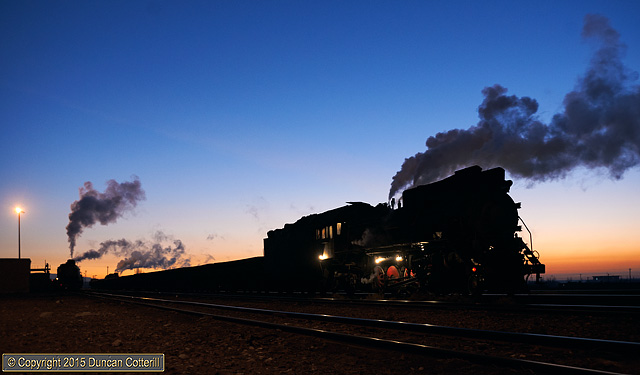
By Dawn's Early Light
It was 08:20 on the morning of 3 December 2015 and there was just an orange glow in the eastern sky. At Dongbolizhan the locos were gathering for shift change. JS.8190 was closest to the camera with JS.8167 on the left and JS.8081, on passenger duty, furthest from the camera.Morning Magic
Dongbolizhan is a magical place at dawn with the light constantly changing as sunrise approaches. Every day is different, with colours and tones influenced by the clarity of the air and the pattern of clouds. Add four wheezing 2-8-2s into the mix and the photographic possibilities are virtually endless.A fresh crew approached JS.8190 as JS.8081 departed with the passenger on 3 December 2015.
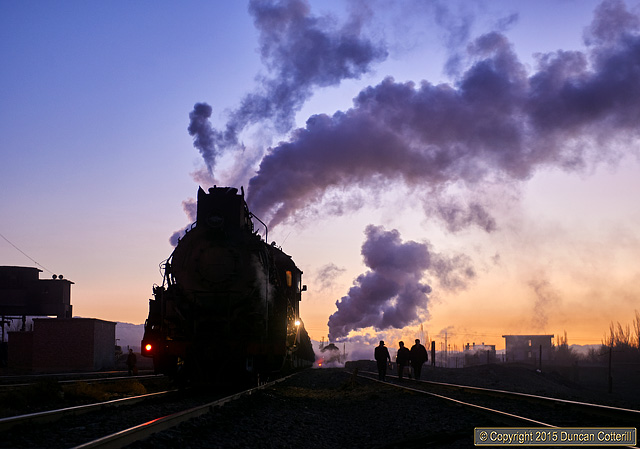
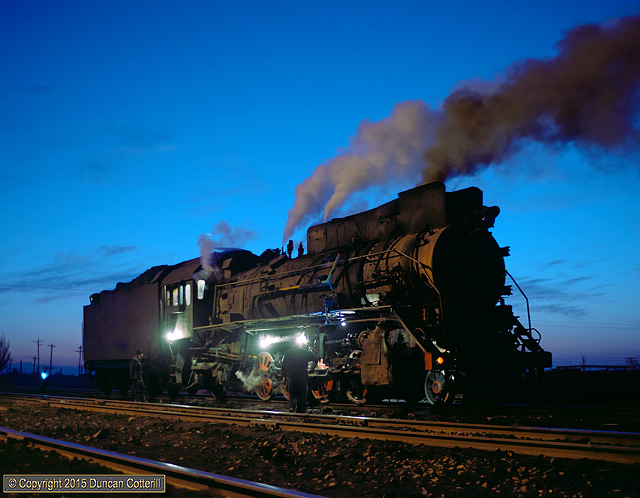
Passenger Engine
Despite reports to the contrary, the passenger train still runs at Sandaoling but only as a light engine with the passengers travelling on the footplate. JS.8190's crew gave the loco the once over prior to departing Dongbolizhan on the passenger duty on 6 December 2015.Sunrise Blowdown
JS.8081 tried to extinguish the sunrise after returning to Dongbolizhan on the passenger duty on 3 December 2015.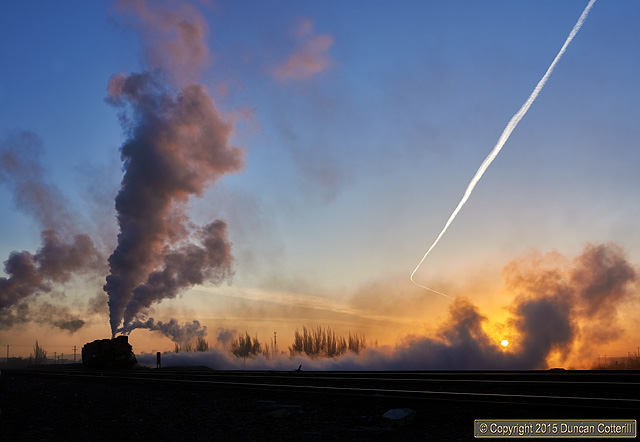
As at Fuxin the weekend brought the hordes to Sandaoling. A large party of Chinese photographers visited Dongbolizhan for the morning shift change on the Saturday and Sunday and managed to upset a couple of the loco crews by getting in the way during shunts. With Bernd's group there on the Sunday morning as well, it was getting quite crowded by the time we left. There were also significant numbers of sightseers on the eastern rim of the pit at the weekend, usually just having a quick look and only staying a few minutes.
The weather was bright and sunny on most days with generally good visibility and clear views of the mountains much of the time. Temperatures were higher than expected and on several afternoons there was little or no visible exhaust by the time trains reached Kengkouzhan.
JS.8314 and at least 3 others in service based at Nanzhan,
unidentified DF8Bs on Liushuquan and Shadunzi duties based at Nanzhan.
The works and dump/store weren't visited.
The weather was bright and sunny on most days with generally good visibility and clear views of the mountains much of the time. Temperatures were higher than expected and on several afternoons there was little or no visible exhaust by the time trains reached Kengkouzhan.
SANDAOLING MINING RAILWAY LOCOMOTIVES
JS.8081, 8167, 8190, 8197, 8225 all in service on opencast coal trains based at Dongbolizhan,JS.8314 and at least 3 others in service based at Nanzhan,
unidentified DF8Bs on Liushuquan and Shadunzi duties based at Nanzhan.
The works and dump/store weren't visited.
Golden Light
JS.8167 reflected the early morning sun as it took water at Dongbolizhan on the morning of 3 December 2015. In the background the snowcapped peaks of the Tianshan can just be seen.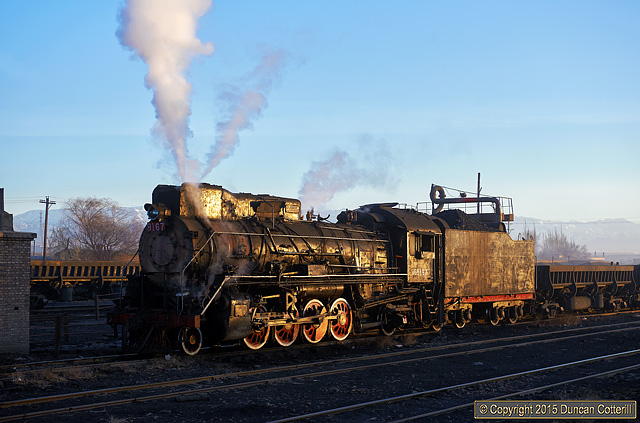
SANDAOLING TO BEIJING
6 December 2015We left Hami at lunchtime on 6 December and travelled by road to Hami Airport for flight CA1268 back to Beijing, another Air China Boeing 737-700. At Beijing we transferred by shuttle bus to the CITIC Hotel (formerly the Sino-Swiss), near the airport, our base for the next two nights.
BEIJING
7 December 2015No day in Beijing is complete without a visit to the Dongnan Jialou, the old watchtower that overlooks Beijing station throat. SS9G electrics seemed to work more trains than on recent visits with HXD3C and HXD3D electrics on most other workings. One of the original SS9s, appropriately SS9.0001, was seen arriving with train 1462 from Shanghai but that was the only other electric seen.
The days of diesels working long distance passengers for hundreds of km under the wires seem to be coming to the end but aren't quite over yet. The stock that arrived on train T66 from Nanjing continued to be diesel hauled to Qinhuangdao for servicing during the day. Previously this was thought to be an empty stock working but was seen with plenty of passengers in the hard seat coaches as it left, meaning it was almost certainly running as train T5687, 10:52 Beijing - Qinhuangdao. Motive power was double unit DF11Z.0003. The DF11Zs are probably the most exotic diesels seen around Beijing these days. Other ECS workings were hauled by DF4BD.1755 and DF4C.5015. Train 6452 from Yancun, north of Tianjin, arrived behind a standard DF11. The use of a DF10F on this train appears to have ceased as no sightings have been reported for some time.
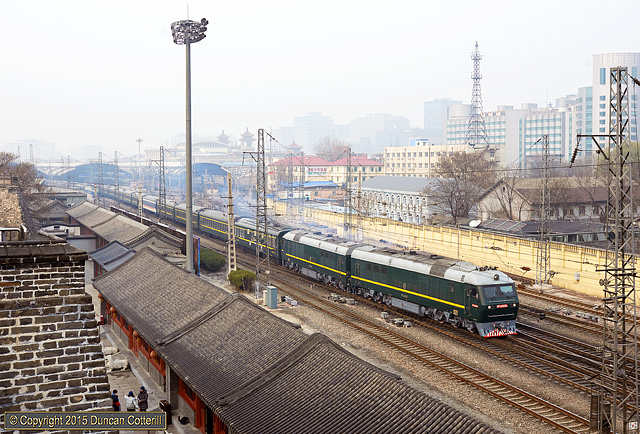
Beijing Departure
DF11Z.0003 left Beijing with T5687, the 10:52 to Qinhuangdao, on a smoggy 7 December 2015.HOMEWARD BOUND
8 December 2015A smooth and fairly relaxed journey with both the Beijing – Helsinki and Helsinki – London flights leaving on time and arriving early and minimal waits for hassle-free security and passport checks. Why can’t it always be like this?
COMMENTS AND CONCLUSIONS
With so little steam left in China these days, each trip seems to start with concern over whether it’s worth going again. After a few days in the presence of hard working SYs and JSs any misgivings disappear and, as the good pics mount up, it seems ridiculous to have ever doubted whether the trip would be worthwhile.It took a little longer for the doubts to subside this time. Nothing to do with the steam, everything to do with the weather. By mid-November winter has usually established itself in northern China and cold clear weather from the north-west predominates. Not this time. Dull weather was the norm for the first week and the first decent light we got was at Pingzhuang and that lasted less than a day. After returning to Fuxin, a cold front passed through, the temperature plummeted and the sky cleared. Minus 21 deg was a small price to pay for good light. From that point onwards the weather was generally good although Sandaoling was still a bit on the warm side and some locations were problematic due to a lack of exhaust.
Overall, a good trip, despite the weather problems. Fuxin and Sandaoling were at least as busy as last year and finding steam working at Pingzhuang was a very pleasant surprise, even though it was short lived. At Fushun we expected nothing worthwhile and that’s exactly what we got. It was encouraging to see freshly overhauled locos at Fuxin and Pingzhuang and the opencast locos at Sandaoling were cleaner than they have been of years. None of this means that they have an assured future of course.
It’s good to see so many Chinese now taking an interest in railways and in steam in particular but the behaviour of many leaves a lot to be desired. It’s not the Chinese railway enthusiasts I’m worried about, they generally know how to behave on the railway and usually don’t get in the way of operations or other photographers, it’s the photographic clubs that are the problem. While behaving ignorantly by getting in the way of other photographers is bad enough, it’s the attitude to safety and lack of respect for the train crews that is most disturbing.
In one instance we saw a line photographers set up their tripods in front of a loco that was ready to leave Dongbolizhan and refuse to move until they’d got their shots of the loco with its drain cocks open. Something similar must have happened at Xikeng a little later when a departing train was forced to stop and then restart with much angry whistling. Another photographer stood just in front of a loco restarting from the signals at Kengkouzhan, out of sight of the crew, took their pictures then calmly moved out of the way at the last second. If they had tripped or stumbled, they would have been dead! None of the mining companies are obliged to allow people onto their property to take pictures and if this sort of interference with their operations is as common as it seems, it wouldn’t be a great surprise if future access was denied to everyone, not just the culprits. It happened when a group behaved irresponsibly at Beitai and could easily happen elsewhere. Unfortunately there’s nowhere else to go these days.
Another threat to steam is the state of the Chinese economy. In the boom days coal was in great demand and mines could sell anything they produced for a good price. Now the rate of growth has slowed and world fuel prices have dropped, many of the older, less efficient mines are finding they can’t cover the cost of production.
In the short term this might mean an increase in the amount of steam working as cash-strapped mines try to cut back on unnecessary expenditure, such as buying diesel fuel when they have coal available that’s effectively free. This was the story we got at Pingzhuang although it turned out not to be the whole story. At Sandaoling we were told that consideration was being given to using steam on the line to Shadunzi to reduce the amount of diesel fuel required but it was far from ideal operationally so there was a lot of resistance.
In the longer term the collapse in coal prices will almost certainly result in the closure of uneconomic mines and these could well be the mines that haven’t been able to afford diesels so far, i.e. those that are still using steam. There were suggestions that Wulong Mine was in financial trouble, hardly surprising given the large amounts of spoil and small amounts of coal it seemed to be producing, and closure would probably finish steam at Fuxin. Sandaoling should be more secure as there aren’t many alternative sources of coal nearby. We’ll just have to wait and see what happens.
My recent trips to China have usually been fraught in one way or another, whether it’s being fogged in for days at Wulumuqi, stuck for hours while KLM try to make their planes work, Baiyin stopping the steam passenger two weeks early or Rongshan pulling the plug altogether. This time, the whole trip went exactly as planned from start to finish. All the planes and trains were on time, give or take a few minutes, and nothing needed to be changed at short notice. It doesn’t happen very often but it’s nice when it does.
Hopefully it won’t be my last trip to China for steam. As long as there’s no significant decline in operations at Fuxin or Sandaoling it will still be worth going back. Unfortunately there aren’t any other steam operations that are worth going a third of the way round the world for. Once Sandaoling and Fuxin bite the dust it will be time to call it a day.
Last Light
The setting sun broke through the cloud for a few brief moments at the end of a grey day. SY.1359 pushed a loaded spoil train up Wulong Tip on the afternoon of 20 November 2015.Even on the dull days China can still produce a few good photo opportunities. When the sun shines and the trains run, it's still exceptionally good.
